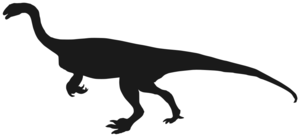- Unaysaurus
|outline
image_width = 250px
regnum =Animal ia
phylum = Chordata
classis = Sauropsida
ordo =Saurischia
superordo =Dinosauria
subordo =Sauropodomorpha
infraordo =Prosauropod a
familia = ?Plateosauridae
genus = "Unaysaurus"
genus_authority = Leal, Azevodo, Kellner, & da Rosa, 2004
subdivision_ranks=Species
subdivision=
*"U. tolentinoi" Leal "et al.", 2004 (type)"Unaysaurus" is a
genus of sauropodomorphdinosaur , and is one of the oldest dinosaurs known. It was discovered in southernBrazil ,in thegeopark ofpaleorrota , in 1998, and announced in a press conference on Thursday,December 3 ,2004 . A member of a group of plant-eatingdinosaur s known as "prosauropod s", it is closely related to a dinosaur found inGermany , which indicates that it was relatively easy forspecies to spread across the giant landmass of the time, thesupercontinent ofPangaea .Like most early dinosaurs, "Unaysaurus" was relatively small, and walked on two legs. It was only 2.5 meters long (8.2 ft), 70 to 80 centimeters tall (2 to 3 ft), and weighed about 70
kilogram s (155 lb).The
fossil s of "Unaysaurus" are well preserved. They consist of an almost completeskull , complete with a lower jaw, and partial skeleton with many of the bones still connected to each other in their natural positions. It is one of the most complete dinosaur skeletons, and the most complete skull, ever recovered in Brazil.One big world
"Unaysaurus" lived about 200 to 225
million years ago , in the Carnian to Norian ages of the lateTriassic period. It was found in the south of Brazil, which at the time was connected to northwestAfrica . The whole world was united into the great supercontinent of Pangaea, which was just starting to divide intoLaurasia in the north, andGondwana in the south."Unaysaurus" was found in the southern Brazilian state of
Rio Grande do Sul , near the city ofSanta Maria . It was recovered from the red beds of the Santa Maria Formation (also known as the Caturrita Formation), which is the geologic formation where similarly old dinosaurs like "Saturnalia" have been found. The oldest dinosaurs in the world are from here and nearby inArgentina (like the "Eoraptor "), which suggests that the first dinosaurs may have originated in the area."Unaysaurus" is the first prosauropod discovered in Brazil. Prosauropods were semi-bipedal, herbivorous dinosaurs that are related to the later and more advanced
sauropod s, which include some of the largest creatures ever to walk the Earth, like the "Brachiosaurus ". "Staurikosaurus ", another early dinosaur, has been discovered nearby, and it is possible that "Teyuwasu ", another Brazilian dinosaur described in 1999, is also a prosauropod.Counter to expectations, however, the closest relative of "Unaysaurus" is not from
South America . It is mostly closely related to the "Plateosaurus ", which lived about 210 million years ago inGermany . This indicates that species were able to migrate relatively easily across Pangaea.Discovery and name
The new species and genus were officially described by Luciano A. Leal, Sergio A. K. Azevodo, Alexander W. A. Kellner, and Átila A. S. da Rosa in the October 18 2004 issue of the scientific journal "Zootaxa". The name "Unaysaurus" comes from the word "unay" (u-na-hee), meaning "black water" in the local Tupy language, which in turn refers to "Agua Negra" (also "black water"), the Portuguese name for the region where the fossils were found. The species epithet "tolentinoi" is named after Tolentino Marafiga, who discovered the fossils by the side of a road in 1998.
ee also
*
Paleorrota References
* cite journal
title = A new early dinosaur (Sauropodomorpha) from the Caturrita Formation (Late Triassic), Paraná Basin, Brazil
author= Luciano A. Leal, Sergio A. K. Azevodo, Alexander W. A. Kellner, and Átila A. S. da Rosa
date =October 18 2004
journal = Zootaxa
volume = 690
pages = 1–24
year = 2004
url = http://www.mapress.com/zootaxa/2004f/z00690f.pdf ("Warning:" abstract is 12 kb PDF)External links
* cite news
title = New dinosaur uncovered in Brazil
url = http://news.bbc.co.uk/1/hi/sci/tech/4064429.stm
first = Steve | last = Kingstone
publisher = BBC News
date =2004-12-03
* cite news
url=http://www.msnbc.msn.com/id/6639601
title= Brazilians find dinosaur linked to Europe
first=Andrei | last=Khalip
publisher = MSNBC
date =2004-12-02
* cite news
url=http://www.news24.com/News24/Technology/News/0,,2-13-1443_1630520,00.html
title = New dinosaur uncovered
publisher = News 24
date =2004-12-03
* cite web
url = http://www.dinodata.org/index.php?option=com_content&task=view&id=7561&Itemid=67
title = "Unaysaurus"
work = DinoData
accessdate = 2007-02-04
* [http://www.royalsul.com.br/paleo/galeria.asp Dinosaurs of Rio grande do Sul.]
Wikimedia Foundation. 2010.

